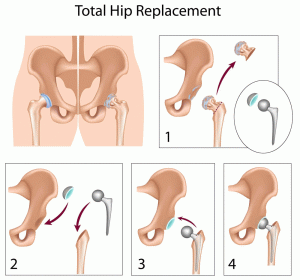Hip replacement
During hip replacement, a surgeon removes the damaged sections of the hip joint and replaces them with parts usually constructed of metal, ceramic and very hard plastic. This artificial joint (prosthesis) helps reduce pain and improve function.
Also called total hip arthroplasty, hip replacement surgery might be an option if hip pain interferes with daily activities and nonsurgical treatments haven’t helped or are no longer effective. Arthritis damage is the most common reason to need hip replacement.

Why it’s done
Conditions that can damage the hip joint, sometimes making hip replacement surgery necessary, include:
- Commonly known as wear-and-tear arthritis, osteoarthritis damages the slick cartilage that covers the ends of bones and helps joints move smoothly.
- Rheumatoid arthritis.Caused by an overactive immune system, rheumatoid arthritis produces a type of inflammation that can erode cartilage and occasionally underlying bone, resulting in damaged and deformed joints.
- If there isn’t enough blood supplied to the ball portion of the hip joint, such as might result from a dislocation or fracture, the bone might collapse and deform.
Hip replacement may be an option if hip pain:
- Persists, despite pain medication
- Worsens with walking, even with a cane or walker
- Interferes with sleep
- Affects the ability to walk up or down stairs
- Makes it difficult to rise from a seated position
Risks associated with hip replacement surgery can include:
- Blood clots.Clots can form in the leg veins after surgery. This can be dangerous because a piece of a clot can break off and travel to the lung, heart or, rarely, the brain. Blood-thinning medications can reduce this risk.
- Infections can occur at the site of the incision and in the deeper tissue near the new hip. Most infections are treated with antibiotics, but a major infection near the new hip might require surgery to remove and replace the artificial parts.
- During surgery, healthy portions of the hip joint might fracture. Sometimes the fractures are small enough to heal on their own, but larger fractures might need to be stabilized with wires, screws, and possibly a metal plate or bone grafts.
- Certain positions can cause the ball of the new joint to come out of the socket, particularly in the first few months after surgery. If the hip dislocates, a brace can help keep the hip in the correct position. If the hip keeps dislocating, surgery may be needed to stabilize it.
- Change in leg length.Surgeons take steps to avoid the problem, but occasionally a new hip makes one leg longer or shorter than the other. Sometimes this is caused by a contracture of muscles around the hip. In these cases, progressively strengthening and stretching those muscles might help. Small differences in leg length usually aren’t noticeable after a few months.
- Although this complication is rare with newer implants, the new joint might not become solidly fixed to the bone or might loosen over time, causing pain in the hip. Surgery might be needed to fix the problem.
- Nerve damage.Rarely, nerves in the area where the implant is placed can be injured. Nerve damage can cause numbness, weakness and pain.
Need for second hip replacement
The artificial hip parts might wear out eventually, especially for people who have hip replacement surgery when they’re relatively young and active. If this happens, you might need a second hip replacement. However, new materials are making implants last longer.
During the procedure
The surgical procedure can be completed within two hours. To perform a hip replacement, the surgeon:
- Makes an incision over the hip, through the layers of tissue
- Removes diseased and damaged bone and cartilage, leaving healthy bone intact
- Implants the replacement socket into the pelvic bone
- Inserts a metal stem into the top of the thighbone, which is then topped with a replacement ball
Blood clot prevention
After hip replacement surgery, you’ll temporarily be at increased risk of blood clots in your legs. Possible measures to prevent this complication include:
- Moving early.You’ll be encouraged to sit up and walk with crutches or a walker soon after surgery.
- Applying pressure.Both during and after surgery, you might wear elastic compression stockings or inflatable air sleeves on your lower legs. The air sleeves squeeze and release your legs. That helps keep blood from pooling in the leg veins, reducing the chance that clots will form.
- Blood-thinning medications.Your surgeon might prescribe an injected or oral blood thinner after surgery. Depending on how soon you walk, how active you are and your overall risk of blood clots, you might need blood thinners for several weeks after surgery.
Physiotherapy
Daily activity and exercise can help you regain the use of your joint and muscles. A physiotherapist can recommend strengthening and mobility exercises and can help you learn how to use a walking aid, such as a walker, a cane or crutches. As therapy progresses, you’ll gradually increase the amount of weight you put on your leg until you’re able to walk without assistance.
Results
Full recovery from a hip replacement varies from person to person, but most people are doing well three months after the surgery. Improvements typically continue during the first year after surgery.
The new hip joint can reduce pain and increase the hip’s range of motion. But don’t expect to do everything you could do before the hip became painful.
High-impact activities, such as running or playing basketball, might be too stressful on the artificial joint. But in time, most people can participate in lower-impact activities — such as swimming, golfing and bicycle riding.

